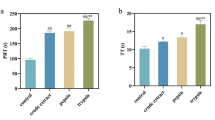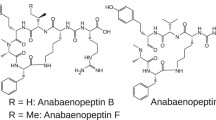Abstract
Optimization of the thrombin inhibitory activities of different enzymatic hydrolysates was conducted, and then an optimal hydrolysis condition by trypsin (5000 u/g) was determined as follows, digested at 45 °C and pH 8.5 for 2 h with a protein concentration of 25 mg/mL. Thrombin inhibitory activity was proved to be 76.92 ± 4.66% under this condition. A total of 39 peptides were identified in the hydrolysate by UPLC-Q-TOF–MS/MS, and all the peptides were predicted to be nontoxic by in silico predictive approaches. Twenty-six peptides were predicted to be anticoagulant peptides by molecular docking method, and the peptide 26 (Lys-Asn-Ala-Glu-Asn-Glu-Leu-Gly-Glu-Val-Thr-Val-Arg) was predicted to be a better anticoagulant peptide through both structure–activity relationship and affinity activity to thrombin. The interactional positions between peptide and thrombin were also involved in the interaction site on the S1 pocket of thrombin and strongly promoted its thrombin inhibitory activity. The firmly non-bonded interactions made the bound of peptide and thrombin firmly. Eventually, the chemical identification and activity verification of synthetic peptide 26 were conducted, and the thrombin inhibitory activity was 89.96 ± 5.30% at the concentration of 9 mg/mL. This study optimized an enzymatic hydrolysis and a virtual screening method for predicting and verifying the anticoagulant peptide from Mytilus edulis, respectively, which provided a good theoretical basis and application method for the research and development of the anticoagulant peptides, especially from the seafood products.






Similar content being viewed by others
References
Lazcano-Pérez F, Román-González SA, Sánchez-Puig N, Arreguin-Espinosa R (2012) Bioactive peptides from marine organisms: a short overview [J]. Protein Pept Lett 19:700–707
Kim SK, Mendis E (2006) Bioactive compounds from marine processing byproducts—a review [J]. Food Res Int 39:383–393
Dutta PK, Tripathi S, Mehrotra GK, Joydeep D (2009) Perspectives for chitosan based antimicrobial films in food applications [J]. Food Chem 114:1173–1182
Najafian L, Babji AS (2012) A review of fish-derived antioxidant and antimicrobial peptides: their production, assessment, and applications [J]. Peptides 33:178–185
Betoret E, Betoret N, Vidal D, Fito P (2011) Functional foods development: trends and technologies [J]. Trends Food Sci Technol 22:498–508
Rajanbabu V, Chen JY (2011) Antiviral function of tilapia hepcidin 1–5 and its modulation of immune-related gene expressions against infectious pancreatic necrosis virus (IPNV) in Chinook salmon embryo (CHSE)-214 cells. Fish Shellfish Immunol 30:39–447
Mann KG, Lorand L (1992) Introduction: blood coagulation [J]. Methods Enzymol 222:1–10
Furie B, Furie BC (1992) Molecular and cellular biology of blood coagulation [J]. N Engl J Med 326:800–806
Davie EW (1995) Biochemical and molecular aspects of the coagulation cascade [J]. Thromb Haemost 74:1–610
Ricardo LH, Walter SH (1960) Proteolytic and polymerase activity of thrombin [J]. Am J Physisiol 198:173–179
Sidelmann JJ, Gram J, Jespersen J, Kluft C (2000) Fibrin clot formation and lysis: basic mechanisms [J]. Semin Thromb Hemost 26:605–618
Chen H, Lyne PD, Giordanetto F, Lovell T, Jin L (2006) On evaluating molecular-docking methods for pose prediction and enrichment factors [J]. J Chem Inf Model 46:401–415
Je JY, Park PJ, Byun HG, Jung WK, Kim SK (2005) Angiotensin I converting enzyme (ACE) inhibitory peptide derived from the sauce of fermented blue mussel, Mytilus edulis [J]. Biores Technol 96:1624–1629
Dai ZY, Zhang YP, Zhang H, Lu YB (2012) Preparation and characterization of mussel (Mytilus edulis) protein hydrolysates with angiotensin-I-converting enzyme (ACE) inhibitory activity by enzymatic hydrolysis [J]. J Food Biochem 36:66–74
Kumar JV, Chen WY, Tsai JJP, Hu WP, et al (2013) Molecular simulation methods for selecting thrombin-binding aptamers [J]. Inf Technol Converg 253:743–749 (Springer, Netherlands)
Wei JT, Chiang BH (2009) Bioactive peptide production by hydrolysis of porcine blood proteins in a continuous enzymatic membrane reactor [J]. J Sci Food Agric 89:372–37817
Adler-Nissen J (1982) Limited enzymic degradation of proteins: a new approach in the industrial application of hydrolases [J]. J Chem Technol Biotechnol 32:138–156
Guérard F, Dufossé L, Broise DDL, Binet A (2001) Enzymatic hydrolysis of proteins from yellowfin tuna (Thunnus albacares) wastes using Alcalase [J]. J Mol Catal B Enzym 11:1051–1059
Nasri R, Amor IB, Bougatef A, Nedjar-Arroume N, Dhulster P, Gargouri J et al (2012) Anticoagulant activities of goby muscle protein hydrolysates [J]. Food Chem 133:835–841
Rojas-Ronquillo R, Cruz-Guerrero A, Flores-Nájera A, Rodríguez-Serrano G, Gómez-Ruiz L, Reyes-Grajeda JP et al (2012) Antithrombotic and angiotensin-converting enzyme inhibitory properties of peptides released from bovine casein by Lactobacillus casei Shirota [J]. Int Dairy J 26:147–154
Yan Z, Li J, Li S et al (2015) Impact of lignin removal on the enzymatic hydrolysis of fermented sweet sorghum bagasse [J]. Appl Energy 160:641–647
Lassoued I, Mora L, Barkia A et al (2015) Bioactive peptides identified in thornback ray skin’s gelatin hydrolysates by proteases from Bacillus subtilis and Bacillus amyloliquefacien [J]. J Proteom 128:8–17
Zhou C, Zhong Q, Rhodes LV et al (2012) Proteomic analysis of acquired tamoxifen resistance in MCF-7 cells reveals expression signatures associated with enhanced migration [J]. Breast Cancer Res 14:R45
Burton LJ, Rivera M, Hawsawi O et al (2016) Muscadine grape skin extract induces an unfolded protein response-mediated autophagy in prostate cancer cells: a TMT-based quantitative proteomic analysis [J]. PLoS One 11:e0164115
Liu R, Zheng W, Li J, Wang L, Wu H, Wang X et al (2015) Rapid identification of bioactive peptides with antioxidant activity from the enzymatic hydrolysate of Mactra veneriformis by UHPLC–Q-TOF mass spectrometry [J]. Food Chem 167:484–489
Savitski MM, Wilhelm M, Hahne H et al (2015) A scalable approach for protein false discovery rate estimation in large proteomic data sets [J]. Mol Cell Proteom 14:2394–2404
Gupta S, Kapoor P, Chaudhary K, Gautam A, Kumar R, Raghava GP (2013) In silico approach for predicting toxicity of peptides and proteins [J]. PLoS One 8:e73957
Rawendra RDS, Chang CI, Chen HH, Huang TC, Hsu JL (2013) A novel angiotensin converting enzyme inhibitory peptide derived from proteolytic digest of Chinese soft-shelled turtle egg white proteins [J]. J Proteom 94:359–36929
Neumann T, Junker HD, Keil O, Burkert K, Ottleben H, Gamer J, Metz G (2005) Discovery of thrombin inhibitor fragments from chemical microarray screening [J]. Lett Drug Des Discov 2:590–594
Corralrodríguez MÁ, Bock PE, Hernándezcarvajal E, Gutiérrezgallego R, Fuentesprior P (2011) Structural basis of thrombin-mediated factor V activation: the Glu666-Glu672 sequence is critical for processing at the heavy chain-B domain junction [J]. Blood 117:7164–7173
Koh CY, Kumar S, Kazimirova M, Nuttall PA, Radhakrishnan UP, Kim S et al (2011) Crystal structure of thrombin in complex with S-variegin: insights of a novel mechanism of inhibition and design of tunable thrombin inhibitors [J]. PLoS One 6:e26367
He D, Gu D, Huang Y et al (2009) Separation and purification of phenolic acids and myricetin from black currant by high-speed countercurrent chromatography [J]. J Liq Chromatogr Relat Technol 32:3077–3088
Ling JY, Zhang GY, Cui ZJ et al (2007) Supercritical fluid extraction of quinolizidine alkaloids from Sophora flavescens Ait. and purification by high-speed counter-current chromatography [J]. J Chromatogr A 1145:123–127
Wu G, Robertson DH, Vieth M (2003) Detailed analysis of grid-based molecular docking: a case study of CDOCKER-A CHARMm-based MD docking algorithm [J]. J Comput Chem 24:1549–1562
Nasria R, Amorb IB, Bougatefa A, Nedjar-Arroume N, Dhulster P, Gargouri J (2012) Anticoagulant activities of goby muscle protein hydrolysates [J]. Food Chem 133(3):835–841
Dodt J, Seemuller U, Maschler R, Fritz H (1985) The complete covalent structure of hirudin. Localization of the disulfide bonds [J]. Bio Chem Hoppe-Seyler 366:379–385
Mao SJ, Yates MT, Owen TJ, Krstenansky JL (1988) Interaction hirudin with thrombin: identification of a minimal bindingdomain of hirudin that inhibits clotting activity. Biochem US 27(21):8170–8173
Biela A, Khayat M, Tan H, Kong J, Heine A, Hangauer D, Klebe G (2012) Impact of ligand and protein desolvation on ligand binding to the S1 pocket of throm-bin. J Mol Biol 418:350–366
Acknowledgements
This study was financially supported by the National Natural Science Foundation of China (31371805), the State key research and development plan “Modern Food Processing and Food Storage and Transportation Technology and Equipment (No. 2017YFD0400200). The authors appreciated the NeoTrident Technology Limited. (Beijing, China) for the guide of molecular docking.
Author information
Authors and Affiliations
Corresponding author
Ethics declarations
Conflict of interest
All the authors have no conflict of interest for this article.
Compliance with ethics requirements
This article does not contain any studies with human or animal subjects.
Rights and permissions
About this article
Cite this article
Feng, L., Tu, M., Qiao, M. et al. Thrombin inhibitory peptides derived from Mytilus edulis proteins: identification, molecular docking and in silico prediction of toxicity. Eur Food Res Technol 244, 207–217 (2018). https://doi.org/10.1007/s00217-017-2946-7
Received:
Revised:
Accepted:
Published:
Issue Date:
DOI: https://doi.org/10.1007/s00217-017-2946-7




